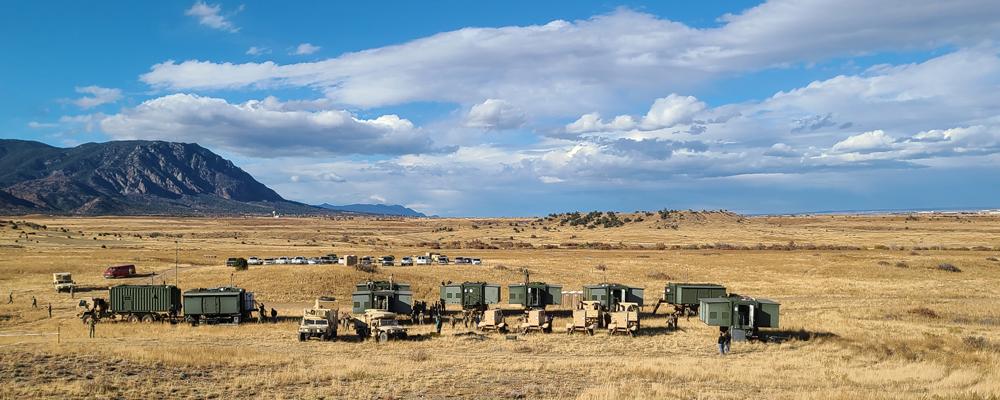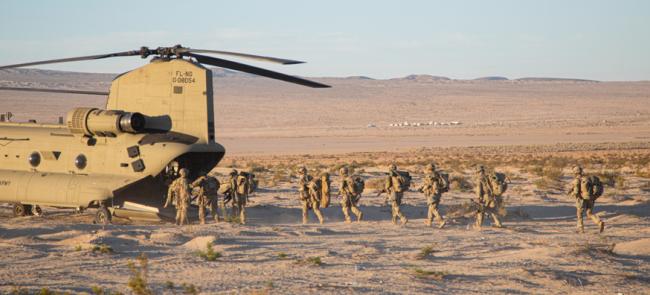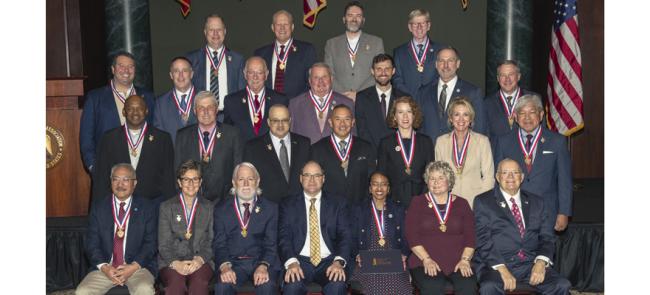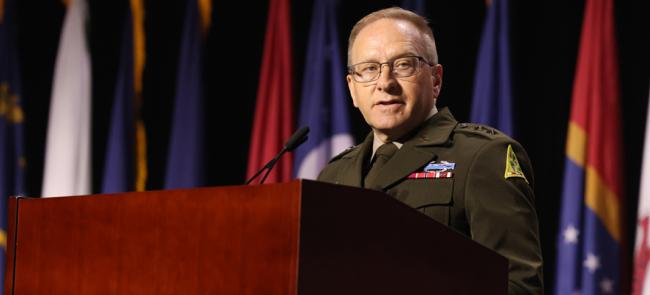
Net Positive
Critical to the success of the Army of 2030 is modernization of the network and its ability to rapidly and securely deliver data to the point of need. Through materiel solutions and embedding cybersecurity across enclaves, Army network modernization focuses on delivering transport-agnostic, data-centric systems underpinned by a modern security architecture.
The Army National Guard is helping shape the future Army network through equipment fielding, tactical cloud pilots and so-called soldier touch points. Additionally, Army Guardsmen are embedded in the Army’s Network Cross Functional Team, or NCFT, and Product Manager Command Post Integrated Infrastructure.
Maj. Gen. John Epperly, the deputy commanding general-Army National Guard of Army Futures Command, says the number of Guard officers working in the modernization and acquisition communities is “an incredible testament to the talent inside the Army National Guard and the power of the Total Army.”
Data & the Cloud
The Guard will benefit from a less-cumbersome Army network, getting data to the user at the geographic point of need. Data is the new ammunition. Much like beans and bullets logistically, data is imperative for the warfighter to win.
The Army network, and the data it carries, must be accessible anywhere, anytime in all environments, against any adversary. The convergence of effects from multiple domains will enable commanders to visualize and understand operations in dispersed environments, whether it’s overseas or in a domestic civil-support role.
A significant element to achieving data centricity is the incorporation of data-fabric technologies to maximize sensor-to-shooter links across echelons and weapon systems on an increasingly networked battlefield. Meeting the future operational tempo will require the Army to quickly assess and evaluate significant volumes of tactical data to establish a deep understanding of the information environment and enable commanders to make informed decisions.
The Army’s tactical data fabric will be delivered as part of the Army’s Command Post Computing Environment, a browser-accessible battle-management software system that enables commanders to see themselves, the enemy and the environment collaboratively.
Army Guard training centers in Arkansas, Idaho, Indiana and Pennsylvania now have CPCE. Fifteen units received it in fiscal 2022, including the 34th Infantry Division and the 20th Special Forces Group. The 28th Infantry Division is in fiscal 2023 fielding plans.
Innovation over time will improve the operational capacity of the command post to enhance friendly and enemy common operating pictures, the collaboration and integration of engineering, logistics, fires, and intelligence warfighting functions.
Data is the new ammunition. Much like beans and bullets logistically, data is imperative for the warfighter to win.
Additionally, the Pennsylvania Army Guard, PM Mission Command and NCFT collaborated on the tactical cloud pilot to explore the use of CPCE in a Non-classified Internet Protocol Router Network Cloud. This effort demonstrated that units could train on new software without the associated hardware. This groundbreaking effort now resonates across the Army as headquarters seek to leverage the benefits of the cloud.
Tactical network fielding efforts delivered more than 2,700 pieces of modernized network equipment to Army Guard and Army Reserve units in fiscal 2022. This includes the fielding of the Ruggedized Applications Platform-Tactical Radio that combines several software applications into a single tactical network management tool to plan, configure, load and monitor legacy waveforms and advanced networking waveforms in current and future tactical radios. Army expeditionary signal battalions will be modernized with the Scalable Network Node.
Army Guard formations will also receive both the large and small Tactical Server Infrastructure version 2 stacks and the Commercial Coalition Equipment. It provides expeditionary coalition or commercial network connectivity to enable mission command, network communications (voice, video and data) and situational awareness between Army, joint and coalition forces. The Army uses CCE to connect to the coalition network over its tactical communications network.
Transforming the Command Post
Transformation to the Army of 2030 is a deliberate and adaptive process to deliver mature and emerging technologies and materiel solutions to the warfighter. Efforts in lab–based risk reduction, field experimentation and soldier feedback are critical pathways in turning science and technology into operational tactical network capabilities.
Mature technology and materiel solutions are bi-annually fielded to units through network capability sets. This incremental approach leverages not only Army and defense science and technology, but also industry commercial off-the shelf solutions and academic research and development advancements.
The Product Manager Command Post Integrated Infrastructure, or CPI2, part of the Program Executive Office for Command, Control and Communications-Tactical, works closely with NCFT to integrate approved COTS solutions and currently developed programs of record systems onto formation-appropriate platforms; providing the command post with improved survivability for corps, divisions, brigades and subordinate battalions, and select multifunctional support brigade commands. In operational assessments, the capability has enabled units to dramatically reduce the time needed to emplace and displace the command post.
Lessons learned in Ukraine are also informing modernization efforts. Advances in loitering munitions and precision-strike capabilities mean large tent cities are no longer a viable means to command and control large scale combat operations. They lack the mobility required to survive.
Command post modernization through the CPI2 effort will introduce the Mission Command Platform, which enables commanders and staff to share data and communications both wirelessly and wired between platforms. The wireless capability supports rapid at-the-halt operations, while the wired capability allows for enhanced operations during position improvement.
The Command Post Support Vehicle serves as the communications node for the brigade and above by hosting servers, radios, local-area network equipment and secure wireless. A key component to assessing data in the command post is Product Manager Network Modernization effort on the secure wireless mesh remote endpoint architecture, which can host wireless through mmWave or various directional and omni-directional Wi-Fi antennas.
Integrated support systems will also add towable expeditionary shelter systems, intelligent power and enhanced camouflage netting. The mobile command group will provide division and corps commanders with access to data and communication on the move.
Tethered technologies to the network and power limit a command post’s ability to disperse. The inclusion of vehicle-integrated power and Wi-Fi between platforms supports greater dispersion and allows the commander to take advantage of the terrain, environment and facilities to rapidly deploy and disperse. Compo-agnostic fielding starts in 2025.
The Guard is integrated with the future Army network. The science and technology driven by the NCFT today will benefit the tactical and enterprise networks, provide global access to data and modernize division and brigade command posts. These modernization efforts will provide the tools and systems for citizen-soldiers to coordinate domestic responses in support of civil authorities such as wildfires, hurricanes and other severe weather.
In addition to homeland missions, emerging technologies can enable greater cooperation with our partners and allies. Modernization will enhance the Guard’s capacity to command and control formations from the unit armory to the edge of the battlefield.
Col. Evert R. Hawk II, a Pennsylvania Army Guard officer, is the Line of Effort 2/3/4 team lead on the NCFT. Maj. Chris Pegg, an Illinois Army Guard officer, is the Line of Effort 4 Command Post Mobility/Survivability lead at the NCFT. Maj. Monty Blamires, an Idaho Army Guard officer, is the assistant product manager for CPI2, managing the increment 0 experimentation. They can be reached via [email protected].



